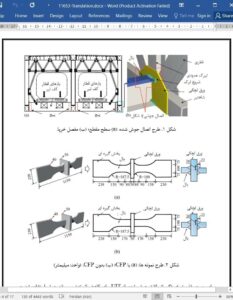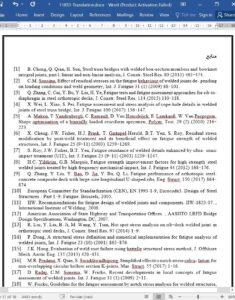Abstract
While welded joints are extensively used in the connections of steel truss bridges, service life of the bridges is largely dependent on the fatigue resistance of the welded joints. Stress concentration and weld residual stress are two primary causes of fatigue damage in the welded joints. In this study, corner-fillet profile (CFP) and ultrasonic impact treatment (UIT) are used to improve the fatigue performance of the welded joints through relieving stress concentration and weld residual stresses, respectively. The fatigue resistance of welded joints is evaluated through experimentation. The results indicate that the use of CFP and/or UIT can alter the initiation location of fatigue crack. The fatigue resistance of welded joints was increased by 24% and 36% by using the CFP and UIT, respectively. The fatigue performance of welded joints was evaluated using three different methods, including the nominal stress method, effective notch stress method, and peak stress method. The peak stress method with a single fatigue resistance curve demonstrated the highest applicability and accuracy.
1. Introduction
Steel trusses have been extensively used in railway bridges and hybrid highway-railway bridges. Steel truss bridges are typically constructed by assembling prefabricated truss components on site. Fig. 1 (a) and (b) show a representative cross section of a main girder in a hybrid highway-railway bridge. The girder is assembled using different truss components, including the chords, vertical posts, diagonal elements, etc. The components are connected through welding and/or using high-strength bolts. Integrated welded joints (Fig. 1(b)) are usually prefabricated in factory to ensure high welding quality. The welded joints between the flange and gusset plates are subjected to varying tensile stresses and other adverse effects on fatigue resistance, and thus susceptible to fatigue damages. In general, the adverse effects include stress concentration, weld defects and residual stresses at welded joints [1–4]. Under cyclic loading, cracks tend to initiate at the welded joints (Fig. 1(b)) and compromise the long-term durability of the truss bridge.
5. Conclusions
The main conclusions are summarized as follows:
(1) The use of CFP and/or UIT changed the fatigue failure mode of the welded joints. Fatigue cracks initiate at the flange plate edges for the welded joints without CFP, and on the flange plate surface for the welded joints with CFP. Fatigue cracks initiate at the weld root or weld of the welded joints with UIT, and at the weld toe of the welded joints without UIT.
(2) The use of CFP and UIT increased the fatigue resistance of welded joints by 24% and 36%, respectively. Combined use of CFP and UIT increased the fatigue resistance by 60%. Compared with CFP, the use of UIT was more effective in enhancing the fatigue resistance.











